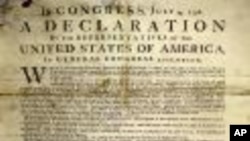Self-government – that is, a people exercising all the necessary
functions of power without interference of a higher authority that they
can’t control themselves -- is a long-standing tradition in the
United States. It is also at the core of the Declaration of
Independence, signed two hundred and thirty two years ago, and which we celebrate today.
Thomas
Jefferson, the document’s primary author, wrote that self-rule is “the
separate and equal station” a people are entitled to under “the laws of
nature and of nature’s God”. It did not come easily. America’s early
history is marked by conflict with other countries threatened by
republican government and among Americans themselves over the ultimate
form that that government would take. But the Declaration laid the
framework for a nation that would endure and grow, inspiring similar
independence movements around the world.
When war first broke
out between Britain and its North American colonists, few imagined, let
alone supported, creation of a new nation. Historians note that even as
the fighting raged, the colonists were deeply divided over the future.
Roughly a third came to believe a complete break was needed, a third
remained loyal to the British crown and a third simply wanted to be
left alone to raise their families and do their jobs.
The
fifty-six men who signed the Declaration on July 4, 1776, cast the
first votes for independence. Their fellow citizens ratified the
choice, and with it the then-radical, but now near universal principle
that government should be based on the consent of the governed.













